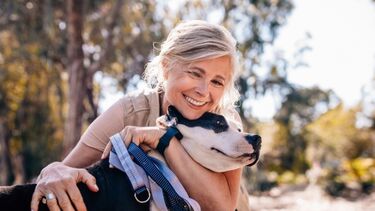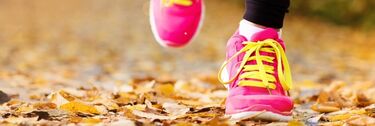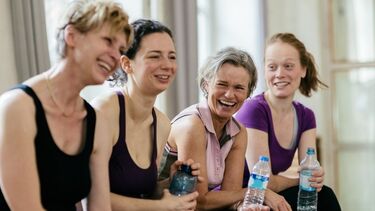
When it comes to protecting your bone health, we often hear about the importance of calcium and weight-bearing exercise. But there's another piece of the nutrient pie that's just as crucial as these two factors, but often overlooked.
What's more, deficiency of this particular nutrient in Australia is very common, especially among women, and, especially at this time of year. The missing piece of the bone health puzzle is vitamin D.
This nutrient bucks the trend of other vitamins, in that we can actually make vitamin D ourselves, by exposing our skin to sunlight – which is why levels are typically lower in winter and spring, when our stores are running out.
Vitamin D is also present in some foods, and of course, supplements. So, given the importance of this vitamin for bone health and the high rates of brittle bones (osteoporosis) in women in Australia, what's the best way to obtain vitamin D? Through sunshine, diet or supplements? How do you know if you're at greater risk of deficiency? And what can you do about it? We speak to Accredited Practising Dietitian Kim Menzies to find out.
Despite our reputation as a sun-soaked country, Australian rates of vitamin D deficiency are alarmingly high – and more common in women than men. Research suggests almost 40% of women in Australia may be deficient, and this jumps to 58% during winter and spring.
There is a lot of emerging and interesting research on vitamin D, but one of its most important and recognised roles is safeguarding our skeletons.

"Vitamin D has an essential role in bone health and that's largely because it increases calcium absorption from the intestine," says Ms Menzies. "When we talk about calcium's important role, we need to talk about calcium and vitamin D because their relationship is so closely intertwined."
Calcium combines with other minerals to give bones their strength and structure, but without enough vitamin D, the capacity to absorb calcium is limited and that's when you'll have a problem.
As well as helping to grow and maintain a strong skeleton and reducing your risk of conditions such as osteoporosis, vitamin D is important for controlling calcium and phosphate levels in your blood, which aid muscle strength.
Recent research has also linked low levels of vitamin D to a wide range of health conditions, from diabetes and some cancers (including colon and breast) to poor brain health in older adults. However, a causal relationship – where low levels of vitamin D actually cause these conditions – has not been established.
However, it seems realising the full extent of vitamin D and its role in human health is still to come, says Ms Menzies. "Watch this space," she says. "Our understanding of this amazing vitamin will continue to unfold in the years ahead."

For most women, one source shines through – most of our vitamin D comes from the sun.
But how much is enough and how much is too much? "We must weigh up the benefits of sun exposure against the risk of skin cancer," Ms Menzies says. "There are ways women can improve their vitamin D levels safely.
"Typically [to produce enough vitamin D safely], you need 5-15 minutes of sun exposure 4-6 times a week outside the peak UV time of 10am-2pm by exposing the bare skin of your hands, arms and face."
These guidelines are for Australia in general, so it's important to know that where you live in Australia, the time of year and numerous other factors, also affect how long you can safely stay in the sun without sunscreen or other protection.
Osteoporosis Australia has a map of Australia, detailing the capital cities and recommended times, to guide you.
Vitamin D is also available through your diet, but diet alone cannot supply the recommended levels, says Ms Menzies.
"We get about 5-10% of vitamin D from food," she says. "Sources of vitamin D include salmon, tuna, mackerel and herring; and smaller amounts are present in beef liver, cheese and egg yolk."
With so many sources of vitamin D coming from animal products, this means that vegans in particular are potentially at higher risk of deficiency.
"In Australia, vegetable oil spreads [margarines], by law, need to be fortified with vitamin D. And some milks are also fortified with vitamin D, but this is voluntarily," Ms Menzies says.

Ms Menzies says supplements have an important place for people who are deficient and need extra vitamin D to correct it.
She also explains that correcting a deficiency, and then maintaining good levels of vitamin D, can look different for different people, so this needs to be directed by a GP.
Whether it's via sunshine, food or supplements, getting enough calcium as well as enough vitamin D is vital for protecting your bones, says Ms Menzies. "There's no point in focusing on one without the other," she says.
So who most needs to pay attention to their vitamin D status? The list includes:
All of these at-risk people are advised to talk to their trusted GP about vitamin D testing.
As parting advice, Ms Menzies urges us to look at the bigger picture when it comes to our health and getting enough vitamin D. Getting out in the sunshine, she says, "can be part of your self-care routine, to take yourself outside every day. Take 5-15 minutes at morning tea, breathe the fresh air, get some feel-good sunshine".
As an added benefit, you'll be making your vitamin D along the way!

All reasonable steps have been taken to ensure the information created by Jean Hailes Foundation, and published on this website is accurate as at the time of its creation.
© 2024 Jean Hailes Foundation. All rights reserved. This publication may not be reproduced in whole or in part by any means without written permission of the copyright owner. Contact: licensing@jeanhailes.org.au